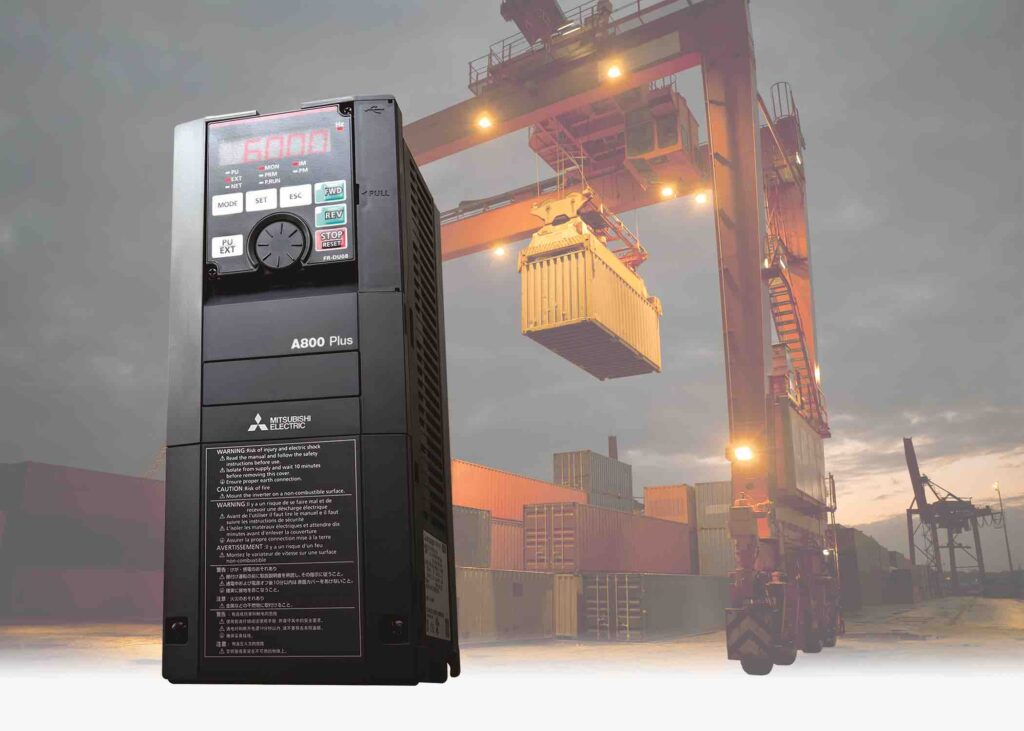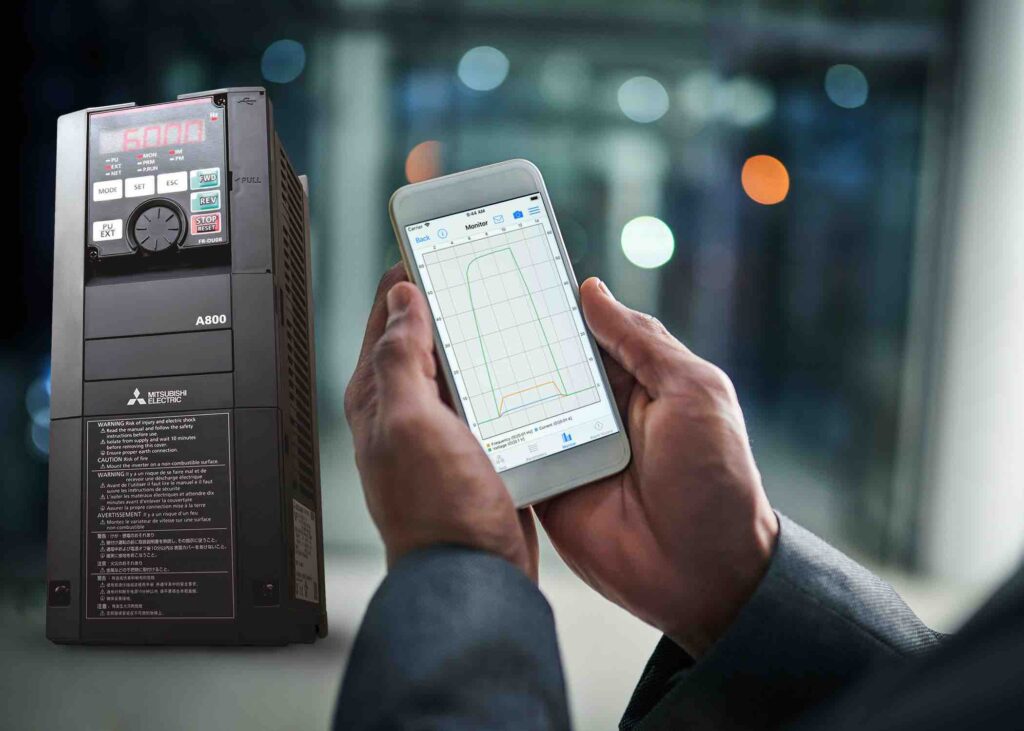Wayne Turtill explores some of the extended functionality of the modern variable speed drive and looks at its potential to integrate into the complete automation platform
The modern variable speed drive (VSD) is the cornerstone of the automation environment, with a single device able to provide effective and efficient speed as well as torque control of a host of different motor types.
In recent years, manufacturers have included comprehensive safety functions, integrated communications, powerful auto-tune capabilities and intuitive software for application set-up but even that barely scratches the surface of the extended functionality within today’s increasingly sophisticated VSD product ranges.
In the early 1980s, the variable speed drive was a revolutionary product, opening up the potential to use low cost AC induction motors in applications where previously the more expensive DC motor was the only option.
Indeed, there was much talk through that decade and beyond of how the VSD had sounded the death knell of the DC motor. This debate proved something of a red herring but certainly the benefits of the VSD and the steadily increasing sophistication of the product as technology has marched on has seen growth rates little short of phenomenal.
This success comes from far more than just being able to turn a low-cost electric motor at a specified speed or torque. Increasingly, it comes from the ability of the VSD to address evolving trends or to tackle industry issues – from the requirement for greater energy efficiency to the need for increased safety.

Today, all of this and more is taken for granted on even the most standard VSD, while the more sophisticated products extend the flexibility of VSDs by operating with an increasingly diverse range of motor types.
As an example, the latest VSDs from Mitsubishi Electric can control not only standard induction and higher efficiency motors but also multi-pole surface permanent magnet (SPM) and interior permanent magnet (IPM) motors.
Later this year there will also be the capability to drive a synchronous reluctance motor, offering ultimate control from a single drive.
However there is more, with advanced functionality extending the capability of the modern variable speed drive beyond just speed and torque control.
With the addition of an encoder on the motor, the VSD can also offer position control, delivering near servo performance in applications that wouldn’t warrant the cost of the servo motor or where the power requirement is too high. Hoists and conveyors would be typical applications.
Another interesting feature is master-slave synchronisation, where the drive can eliminate the need for mechanical components such as shafts, cams and gears.
If two shafts need to be synchronised, the VSD can be electronically locked to an encoder on the first shaft and use this signal to drive the motor on the second. As the master reference changes, the slave has to follow. This flexible control philosophy has been used in countless conveyor applications, eliminating the need for a separate external controller. There is also the ability to alter the ratio between the master and the slave, providing an electronic gearbox and all of this is possible simply with the addition of an encoder option card and the setting of a few parameters.
Smart functions in drives
While the likes of position control and master-slave synchronisation represent useful additional functionality, it is the latest smart functions that really open up the potential of the variable speed drive as an automation platform.
For example, it is now common to find a PLC embedded within the VSD, enabling many small and even medium sized automation applications to be solved by combining logic control and sequencing with the drive’s ability to control the motor.

In multi-drive applications, as long as one of the VSDs has an in-built PLC, it is possible to use a VSD link function to facilitate communication between multiple drives, allowing a small-scale master-slave control system to be implemented without the need for an additional PLC.
Typical applications might include a self-contained, duty assist, standby pumping system (taking advantage of the pump control capabilities of the modern VSD) or a multi-VSD conveyor system. With the addition of an operator interface such as a Mitsubishi Electric GOT HMI, the solution is a completely self-contained automation system. It is also possible to access drives wirelessly that might be installed in hard-to-reach locations, enabling simple remote monitoring of the drive and the ability to fine-tune the VSD without the need to physically be next to it.
Increasingly sophisticated diagnostics capability is extending the capability of VSDs even further, providing a platform for predictive maintenance. A modern VSD such as the Mitsubishi Electric A800 series drive has the ability to monitor some of its own internal components, including the cooling fan, control circuit capacitor, main circuit capacitor, power module and fault contact relay.
The VSD monitors operational time and duty cycles and warns when these key components are nearing the end of their expected lifespan, giving maintenance engineers the opportunity to replace parts during scheduled downtime and eliminating unexpected failure.
A diagnostics function unique to Mitsubishi Electric VSDs is H2S contamination monitoring of internal components, giving an output to warn of potential drive failure. This is particularly relevant in any application where there is decaying organic matter such as found in water treatment works or effluent plants.
The VSD can also derive health information about the load it is driving, comparing the current drawn with the figures recorded during commissioning – a representation of the relationship between speed and torque under normal operating conditions. In a fan application for example, an increase in the current drawn might be indicative of a blocked filter or debris build-up on the fan blades.
Conversely, in a conveyor application, a sudden drop in the current drawn could highlight a broken drive belt or trunnion.
The VSD can output different warning signals at preset levels of current drawn. This can initiate specific remedial functions such as a clean cycle on a pump application or even stop the system in the event of particular conditions to prevent additional costly damage within the application.
Most recently, Mitsubishi Electric has extended the diagnostics capabilities of VSDs by integrating Smart Condition Monitoring (SCM) technology, introducing the concept of drive-based condition monitoring. The pre-configured, plug-and-play solution includes the SmartCheck vibration sensor from Mitsubishi Electric’s e-F@ctory Alliance partner Schaeffler and utilises the VSDs integrated PLC to provide a complete drive-based solution for preventative maintenance.
Within the VSD, operating temperature and vibration feedback from the SmartCheck sensor is combined with the monitoring of a full range of other external parameters. These include speed, voltage and current information, with detailed diagnostics highlighted on an integrated GOT display. With this added diagnostics capability, it is now possible to not only monitor the health of the VSD but also the health of the asset.
All of this extended functionality is given additional power when network capability within the VSD is considered. With a host of protocols supported without the need for option cards and indeed the ability to communicate over two different protocols simultaneously, there is a seamless flow of data from the drive. This encompasses plant level communication, via CC-Link for example, up to controller level, edge computing level or the higher level enterprise over Ethernet.
Special purpose drives
While many VSDs are general purpose products suited to a wide range of applications, there is a growing trend to incorporate features specific to given tasks.
Pump control is an example in VSDs from many manufacturers but what about even more specialised tasks? These can be addressed through dedicated parameters or the addition of specific hardware within the VSD.
Examples include sensorless torque control to regulate tension in a winding application, such as in a paper mill, where the VSD adjusts the torque command value according to the inertia of the paper roll. This function also supports taper tension and inertia compensation.
Traditionally all of this would be regulated by external tension controllers, with feedback to the PLC and a control signal sent to the VSD but with sensorless torque control built in, the VSD can handle it all with just the setting of a few internal parameters.
For crane and hoist applications, where there is a tendency for the load to act like a pendulum, Mitsubishi Electric has developed a set of configurable algorithms that can be used to lessen or even eliminate this effect. A further function can prevent crabbing on travel cranes by providing synchronisation of the driven wheels.
All of this extended functionality represents the here and now for VSDs, delivering enhanced capability for some extremely challenging as well as sophisticated applications. It takes the drive well beyond just speed and torque control and highlights how the modern VSD can truly form the basis of a highly sophisticated automation platform.
Image 1: The latest smart functions open up the potential of the variable speed drive as an automation platform for challenging and sophisticated applications. Image : Mitsubishi Electric Europe BV
Image 2: For crane and hoist applications, where there is a tendency for the load to act like a pendulum, Mitsubishi Electric has developed a set of configurable algorithms that can be used to lessen or even eliminate this effect. Image : Mitsubishi Electric Europe BV
Image 3: The Mitsubishi Electric Inverter StartApp provides convenient commissioning, maintenance, troubleshooting, parameterisation and monitoring support for the company’s FR-F800E and FR-A800E inverters. Image : Mitsubishi Electric Europe BV
Wayne Turtill is Product Manager for Variable Speed Drives, Servos and Low Voltage Switchgear at Mitsubishi Electric UK.
 Engineer News Network The ultimate online news and information resource for today’s engineer
Engineer News Network The ultimate online news and information resource for today’s engineer





